Alfa Laval Compablocs recover energy at Canadian refinery
Shell replaced the shell-and-tube condensers at its refinery in Sarnia, Ontario with eight Alfa Laval Compabloc condensers. The new Compablocs are used as overhead condensers for overhead vapour stream from the main fractionator in the fluidized catalytic cracking unit (FCCU), where the main product is gasoline.
DATE 2023-11-28The original plan was to upgrade the metals used in the existing shell-and-tube exchangers in an attempt to reduce the effects of corrosion in the tube bundles, caused by bisulphides, chlorides and cyanides present in the overhead vapour.
There are eight Compabloc exchangers arranged in four parallel series of two. The top four units recover heat to the boiler feedwater system, while the bottom four are trim coolers using process cooling water.
Product
The Compabloc is a high-efficiency all-welded compact heat exchanger designed for aggressive or hazardous process duties. Compablocs are available in six sizes, with heat transfer areas ranging between 0.7 to 320 m2 (7 to 3,450 sq ft).
Benefits
- Eliminates the corrosion problems previously encountered.
- Recovering heat in the process, that means the steam plant still has additional capacity to meet any future increase in demand.
- Economical recovery of a large amount of energy from the condensing stream.
- Saving space lower installation costs.
Customer's voice
The shell-and-tube design wasn't feasible because we couldn't come up with a configuration that would have delivered the required heat recovery and respect the very low pressure drop constraint imposed by other process requirements.
Dr Erich Wonchala, Head Engineer, catalytic reforming and heat integration

